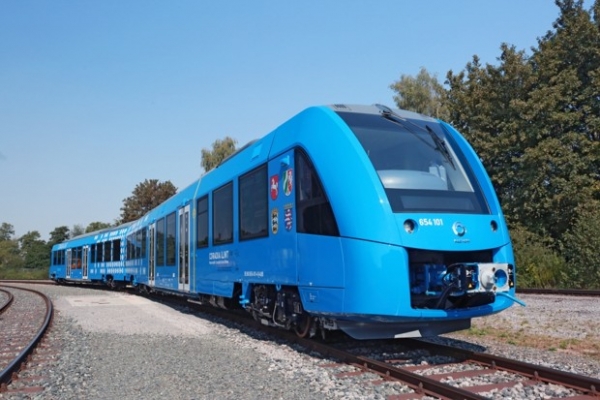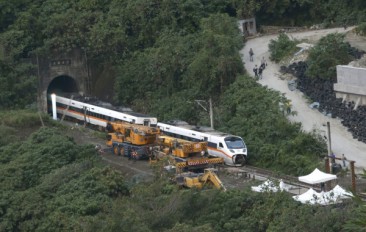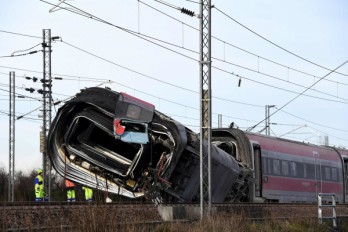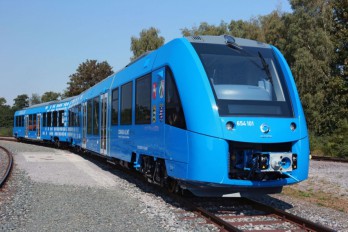World's first hydrogen-powered passenger train will be launched in Germany next year

Coradia iLint is a new CO2-emission-free regional train, providing an alternative to diesel power
Coradia iLint is a new CO2-emission-free regional train, providing an alternative to diesel power
Hydrogen technology in railways seems to be the new environmentally friendly alternative to the diesel trains that are still widely used. The hydrogen train (or hydrail) may not be a high-speed one, but it is very quiet, emission-free and because of its much larger fuel capacity, it does not face the refueling issues that plague hydro-cars. Also, in comparison to electric trains, it is more versatile as it can also run on non-electrified rails. This new 300-passenger train, called the ‘Coradia iLint’, has been developed over the past two years by French company Alstom and is set to run on the Buxtehude-Bremervörde-Bremerhaven-Cuxhaven line in Lower Saxony starting in December 2017. It will be the first hydrogen passenger train to regularly operate on long-distance journeys.
Its characteristics
‘Coradia iLint’ is special for its combination of different innovative elements: Clean Energy, Flexible Energy Storage and Smart Energy Management of the traction power and remaining energy. The train’s motor gains its power from a hydrogen tank and a fuel cell which converts hydrogen’s chemical energy into electricity. Any energy not used immediately will be stored in lithium batteries attached to the car bottom. The hydrogen tank, stored on the roof of the train, is large enough to fuel a 800km (497-mile) journey, at a top speed of 140 km/hr (87 mph). The train is also carbon-neutral, as the hydrogen it will use is already created as a waste product (ex. by the chemical industry) and it will only emit steam and condensed water as a by-product.
‘Alstom is proud to launch a breakthrough innovation in the field of clean transportation which will complete its Coradia range of regional trains,’ said Alstom chairman and CEO Henri Poupart-Lafarge, in a statement. ‘It shows our ability to work in close collaboration with our customers and develop a train in only two years’, he added. Transport authorities in Baden-Württemberg, Hesse and North Rhine-Westphalia also want such trains for their states, and the company says other countries like the Netherlands, Denmark and Norway have also expressed interest.
Check out the video below for more information on the technology used:
Video Courtesy Alstom
Source: The Local.de
Source: The Local.de
Media
Want to read more like this story?

Freight train derailed in Massachusetts, U.S.A.
Mar, 23, 2023 | NewsA freight train was derailed in Ayer, Massachusetts, on Thursday, March 23. More specifically, th...

China tests first driverless sky train
May, 09, 2023 | NewsChina’s first driverless sky train had its first trial run on May 9, in Wuhan’s hi-tech park. This...

Head-on train crash in Greece
Feb, 28, 2023 | NewsA high-speed, head-on collision between a freight train and a passenger train took place in Greece...

Train derails into a tunnel in Taiwan: 50 people dead
Apr, 12, 2021 | News50 passengers have been reported dead and numerous more injured after a train derailed into a tunnel...

Train derailment in Italy: 2 casualties
Feb, 07, 2020 | NewsThe derailment of a high-speed train in Italy resulted in 2 fatalities and numerous injuries. The...

First Hydrogen-Powered train in the world launched in Germany
Oct, 03, 2018 | NewsThe first hydrogen-powered railway, introducing a more eco-friendly technology of transporting, was...

London's first hydrogen filling station opened its gates
May, 18, 2016 | NewsThe hydrogen fuel station in Teddington uses excess or 'spare' electricity on the grid to generate i...

Hydrogen and Nuclear Energy Unite to Cut Asphalt’s Carbon Footprint
Mar, 03, 2025 | NewsThe construction industry is taking a bold step toward sustainability with the introduction of nucl...

Passenger train derailed in the Netherlands after collision with construction crane
Apr, 04, 2023 | NewsA passenger train collided with a crane near Voorschoten, the Netherlands, around 3.25 a.m. in the...
Trending

Vertical gardens in Mexico City to combat pollution

Saudi Park Closed After 360 Big Pendulum Ride Crashes to Ground, 23 injured

Characteristics of Load Bearing Masonry Construction

Taipei 101’s impressive tuned mass damper

Dutch greenhouses have revolutionized modern farming

Federal court rules Biden’s offshore drilling ban unlawful


